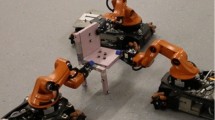Abstract
Flexible assembly machines may be improved and costs reduced by relaxing constraints on part fixturing accuracy and employing compliant devices in assembly effectors. An effector-mounted remote center compliance device that corrects for spatial misalignments of prismatic parts of general cross section has recently been demonstrated. This “spatial RCC” was designed by planning for the possible fine motion assembly contact states given a range of initial position and orientation uncertainty between the mating parts. These fine motion contact states are arranged in a constraint network in the fashion of a Petri net controller, however, the control transitions are mediated by compliances reacting to contact forces rather than from force sensing and discrete event controller schemes. A path through the constraint network of a square peg and hole task is found from initial to final assembly states. This path defines a single compliance relationship that is realized with a practical assembly device. Extensions of this design technique to other assembly tasks are discussed.
Similar content being viewed by others
References
Drake, S. H., Watson, P. C. and Simunovic, S. H. (1977) High speed assembly using compliance instead of sensory feedback. Proceedings of the 7th International Symposium of Industrial Robots.
Eppinger, S. D. and Seering, W. P. (1992) Three dynamics problems in robot force control. IEEE Trans. on Robotics and Automation, 8(6), 751-758.
Khatib, O., Yokoi, K., Brock, O., Chang, K. and Casal, A. (1999) Robots in human environments: Basic autonomous capabilities. International Journal of Robotics Research, 18(7), 684-696.
Kitagaki, K., Ogasawara, T. and Suehiro, T. (1993) Methods to detect contact state by force sensing in an edge mating task. Proceedings of the IEEE International Conference on Robotics and Automation.
Laowattana, S. and Sturges, R. H. (1995) Contact states for square peg and hole insertion tasks. Technical Report CMU-RI-TR-95-TBD, Carnegie Mellon University Robotics Institute, Pittsburgh, PA 15213-3890.
McCarragher, B. J. and Asada, H. (1993) A discrete event approach to the control of robotic assembly tasks. Proceedings of the IEEE International Conference on Robotics and Automation, 1.
Oh, S. R., Hollis, R. L. and Salsudean, S. E. (1993) Precision assembly with a magnetically levitated wrist. Proceedings of the IEEE International Conference on Robotics and Automation, 1, 127-134.
Ohwovoriole, M. S. and Roth, B. (1981) An extension of screw theory. Journal of Mechanical Design, 103.
Paetsch, W. and Wichert, G. V. (1993) Solving insertion tasks with a multifingered gripper by fumbling. Proceedings of the IEEE International Conference on Robotics and Automation, 3.
Patterson, T. and Lipkin, H. (1990) A classification of robot compliance. ASME Design Technical Conference, Chicago.
Riley, F. J. (1983) Assembly Automation, Industrial Press, New York.
Simunovic, S. (1975) Force information in assembly processes. 5th International Symposium on Industrial Robots.
Skinner, F. (1973) Design of a multiple prehension manipulator system. University of Massachusetts, RSB-20.
Sturges, R. H. (1990) A quantification of machine dexterity applied to an assembly task. International Journal of Robotics, 9(3), 49-62.
Sturges, R. H. and Laowattana, S. (1992) Virtual wedging in three dimensional peg insertion tasks. Proceedings of the 1992 IEEE/RSJ International Conference on Intelligent Robots and Systems.
Sturges, R. H. and Laowattana, S. (1994) Polygonal peg insertion with orthogonal compliance. The 1994 Japan-USA Symposium on Flexible Automation, Kobe, Japan.
Sturges, R. H. and Laowattana, S. (1995) Design of an orthogonal compliance for polygonal peg insertion. Journal of Mechanical Design, 118(1), 106-114.
Sturges, R. H. and Sathirakul, K. (1996) An analysis of multiple peg and hole insertion tasks. ASME DTC/CIE96, Irvine, CA, August.
Suehiro, T. and Takase, K. (1990) Representation and control on contact and its application to assembly tasks. The 5th International Symposium on Robotics Research, MIT Press.
Whitney, D. E. (1982) Quasi-static assembly of compliantly supported rigid parts. Journal of Dynamic Systems, Measurement and Control, 104, 65-77.
Whitney, D. E. (1987) Historical perspective and state of the art in robot force control. International Journal of Robotics Research, 6(1), 3-14.
Author information
Authors and Affiliations
Rights and permissions
About this article
Cite this article
Sturges, R.H., Laowattana, S. Constraint network analysis of 3-dimensional insertion tasks. Journal of Intelligent Manufacturing 13, 19–38 (2002). https://doi.org/10.1023/A:1013624912122
Issue Date:
DOI: https://doi.org/10.1023/A:1013624912122




